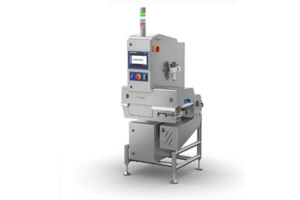PACKAGING CASE STUDIES
-
Proving The Value Of Augmented Reality In Protein Packaging
Explore the study of a collaborative team approach to designing a pilot for a protein packaging line to incorporate and demonstrate the value of augmented reality.
-
Inline Weighing Technology Offers Additional Quality Check Features
Alongside weight monitoring, the checkweigher used at Protina Pharmazeutische GmbH offers other important functions that support the company's system of strict quality management.
-
Rotary Piston Filling & Sealing System Benefits A Cream Cheese Processor
A cream cheese manufacturer spent years grappling with how to deal with the product’s high viscosity. Implementing a rotary piston filling and sealing machine was the company's best solution.
-
Boosting Efficiency With A Filling & Sealing Packaging System
A cheese manufacturer was looking for a packaging solution for its line of spreadable products. The challenge: doing it on one machine, with quick changeover, and with an OEE greater than 95 percent.
-
New Packaging And Filling Systems Boost Sauce Manufacturer's Efficiency
This case study explains how Tomamore GmbH, a start-up in the ready-meals market, researched, evaluated, and implemented automated packaging and filling systems to boost its processing efficiency.
-
Package Integrity: Crucial To Increasing Shelf Life Of Coffee Products
Every packaging format presents its own unique challenge to product quality. This effective package integrity test method can provide accurate and sensitive feedback to assure a high level of quality.
PACKAGING WHITE PAPERS
-
Ensuring Conformity Of Packaged Food
In this white paper, we define package conformity and why it's important to food industry stakeholders. Further, we explore the technologies available to meet conformity objectives and how using them can benefit your business.
-
Calculating ROI On Product Inspection For The Dairy Industry
Need to eliminate product giveaway while reducing the possibility of recalls? See how package weighing and inspection solutions maximize speed and safety while saving money in dairy applications.
-
An Introduction To Vacuum Decay Leak Testing
Vacuum decay tests for container integrity by drawing vacuum on a package within a test chamber and monitoring the vacuum level for any decay, indicating a leak. Is it applicable for your food product?
-
Hygienic Design: Safety And Efficiency In Food Production
In food production, microorganisms present omnipotent risk. This is why facilities, machine builders, and component manufacturers face the increasing challenge of hygienic desgin.
-
Know Your Application Before Being Pulled (Fooled) by the Strongest Magnet
The strength of the magnet may not be the most important factor to consider. First and foremost, you need to think about the details of your manufacturing application and the environment in which the magnet will function, then you can determine which magnet is best for your separation process. It is advisable to consult with a magnetic separator supplier who has expertise and historical knowledge of which systems work and which do not.
-
Selecting The Most Appropriate Packaging Barrier For Coffee
What makes coffee great? As with most food products, we “experience” them using a combination of aroma and taste. Fresh coffee is great coffee! That being said, “aromas” are good and “odors” are bad. You want to keep the aromas in and the odors out… so how can you ensure this happens? Aroma & Flavor testing can make all the difference in ensuring a great product with the best possible aroma and flavor!
PACKAGING APPLICATION NOTES
-
The Rise In Pouch Packaging For The Pet Food Industry
Pouches offer a convenient, consumer-friendly option for food packaging, especially within the pet food industry. But how do you efficiently and effectively fill pouches on a commercial scale?
-
Rapid Fungal Detection In Yogurt
Yogurt is a popular with consumers, nutritious, and can be packaged easily to accommodate different serving sizes and flavors. Dairy producers are aware of potential spoilage issues that negatively affect the customer experience. Fungal contamination (yeasts and molds) can be introduced from a variety of sources, including added fresh fruit purees or airborne particles. Some packaged yogurts may also generate excess moisture under the foil cap that is a breeding ground for mold growth. While primarily a spoilage and shelf life issue, there have been recent occurrences of yeast and mold contamination causing illness.
-
The Importance Of Testing The Entire Package For Shelf Life Results
The shelf life of a product in a package can be very different from the projected shelf life obtained from testing a flat film. Most packaging R&D work is done using flat films, which is essential for identifying suitable packaging materials. However, when a film is formed into a package, defects created during the manufacturing process as well as during shipping or distribution can weaken the barrier provided by the package as a whole. This must be taken into account during development or the shelf life of the product may be less than expected, which can lead to problems such as recalls or even legal action.
-
Permeation Data In The Packaging Process
Shelf life is the length of time that foods, beverages, pharmaceutical drugs, chemicals, and many other perishable items are given before they are considered unsuitable for sale, use, or consumption.
-
Assessment Of Enterobacteriaceae Bacterial Load In Beef
Enterobacteriaceae bacteria (EB) are commonly found in meat products such as beef. Levels from 10 to 1,000 colony forming units per gram (CFU/g) can be found in raw meats in the USA and Europe. Meat has a high degree of variability in how it was butchered, packaged, and how many additives may have been introduced. Because of the variables the control specification for enterobacteriaceae counts are generally 1,000 CFU/g.
-
Texture Analysis Of Apples
Shipping fruit is a challenge. The question for packaging professionals in the food industry is, “How much protection for the product is needed?” Many factors, such as distance being shipped, storage times, storage conditions, and the fruit’s ripeness, must be evaluated when making this decision. Fortunately for apple processors and packagers, analyzing apples’ texture can help aid in packaging and shipping decisions.
NEWS
-
Unsere Grüne Glasfaser And Solutions30 Launch A Strategic Partnership To Deliver Fiber Optic Connections To German Homes.1/15/2024
Strategic partnership between Solutions30 and Unsere Grüne Glasfaser (UGG), a joint venture of Allianz and Telefónica, to roll-out a fibre optic FTTH network in Germany
-
California Water Service Group Utilities Prepared To Comply With New PFAS Regulations4/10/2024
Following the U.S. Environmental Protection Agency’s (EPA) adoption of a new National Primary Drinking Water Regulation for certain per- and polyfluoroalkyl substances (PFAS) today (new PFAS regulation), California Water Service Group (Group) (NYSE: CWT) confirmed that it believes its subsidiaries are well positioned to treat potentially impacted water sources and to meet the EPA’s five-year compliance timeline.
-
New Approach To Monitoring Freshwater Quality Can Identify Sources Of Pollution, And Predict Their Effects3/28/2024
The source of pollutants in rivers and freshwater lakes can now be identified using a comprehensive new water quality analysis, according to scientists at the University of Cambridge and Trent University, Canada.
-
Biden-Harris Administration Announces $24M In Pollution Prevention Grants Under President's Investing In America Agenda3/18/2024
Today, March 18, the U.S. Environmental Protection Agency announced the availability of nearly $24M in grants to support states, U.S. territories, and Tribes in providing technical assistance to businesses to develop and adopt pollution prevention practices.
-
Global Water Resources To Acquire Seven Water Systems From Tucson Water, Adding 2,200 Customer Connections5/7/2024
Global Water Resources, Inc. (NASDAQ: GWRS), a pure-play water resource management company, has entered into an agreement to acquire seven water systems from the City of Tucson’s water utility.
ABOUT
Food Online Packaging
Food packaging is a big industry. Food packaging is used for many purposes including protection, tampering resistance, temperature control, chemical or biological needs. Packaging also includes the labeling of foods.
Barrier protection is a primary reason many foods must be packaged. Many foods cannot be exposed to oxygen or water vapor. The permeability of the packaging is a critical factor in package design. Some packages contain desiccants or oxygen absorbers that help extend the shelf life of certain food products.
Another function of packaging is to contain or agglomerate product. Many products consist of small items and these get packaged together in bottles, multi-packs or blister packs. This is primarily for efficiency, but certain powders and granular foods must have some form of containment such as a box, bag or jar.
Labeling provides a way for food manufacturers to transmit information about a product. Labels are important to be in compliance with regulatory requirements and they are important as a way to promote and market the brand.
Packaging also plays a vital role in terms of food security. Many packages offer tamper resistance to deter tapering or tamper evident features. These are special qualities that help indicate when tampering has occurred.
Many packages are designed specifically to deter pilferage with special authentication seals. Packages can also be designed to include anti-theft devices like RFID tags or electronic surveillance tags. These are designed for retail loss prevention.
Other uses of food packaging include convenience for retailers and consumers and can include features like stackability, and re-closable lids.












